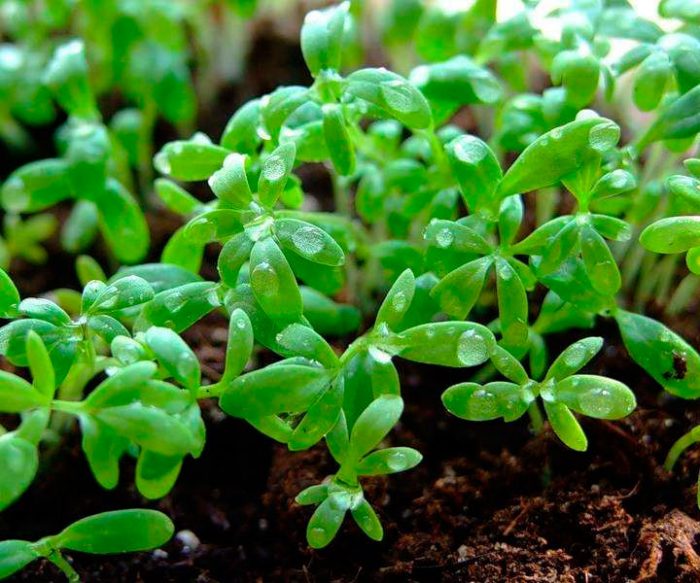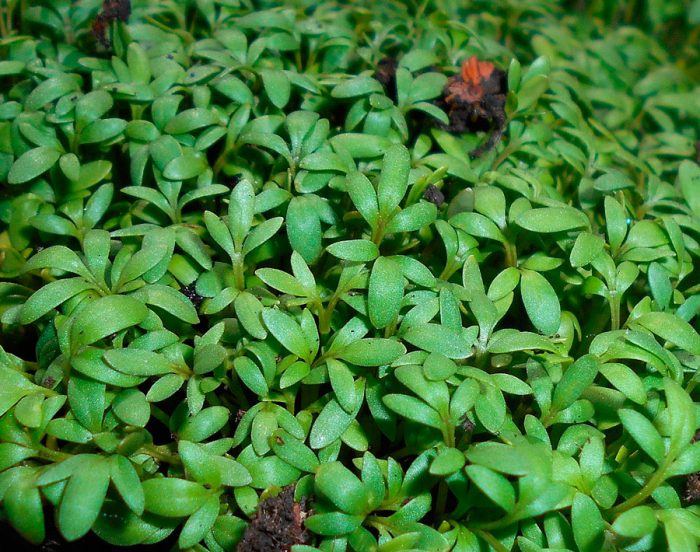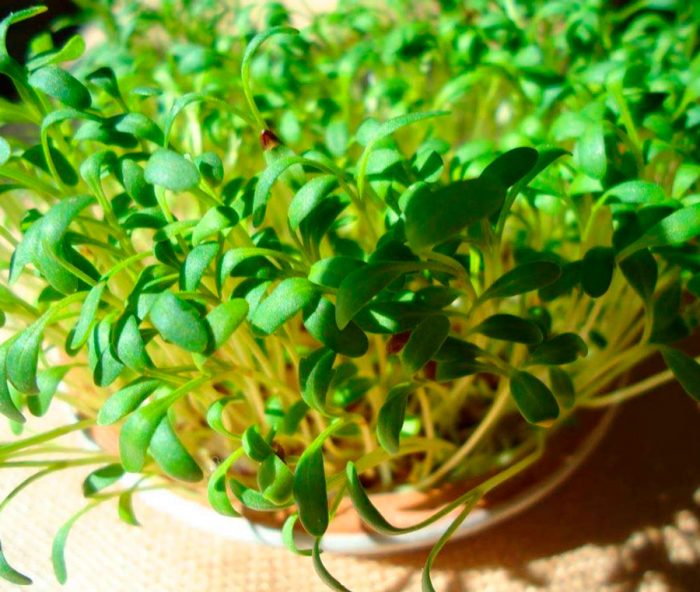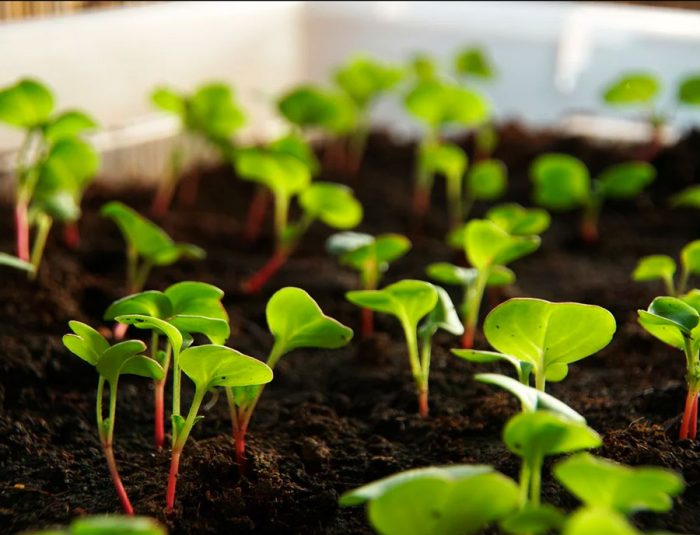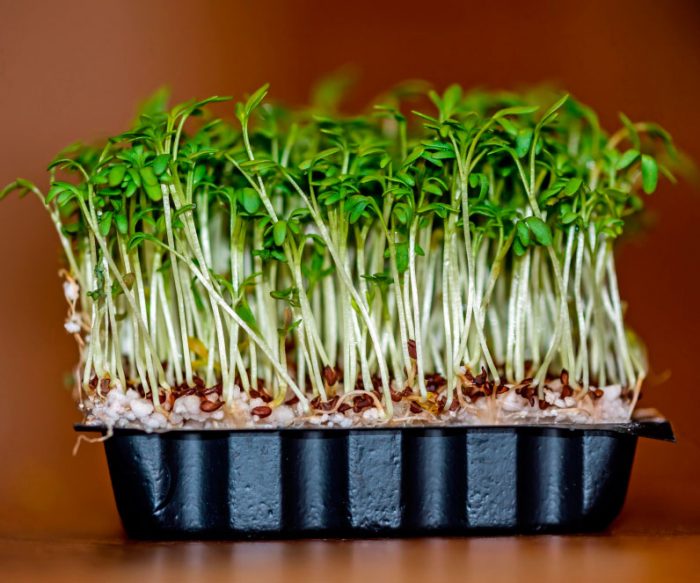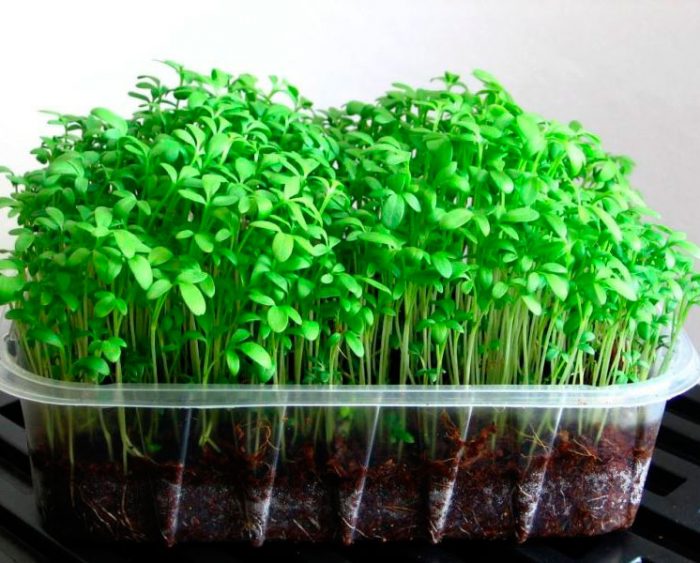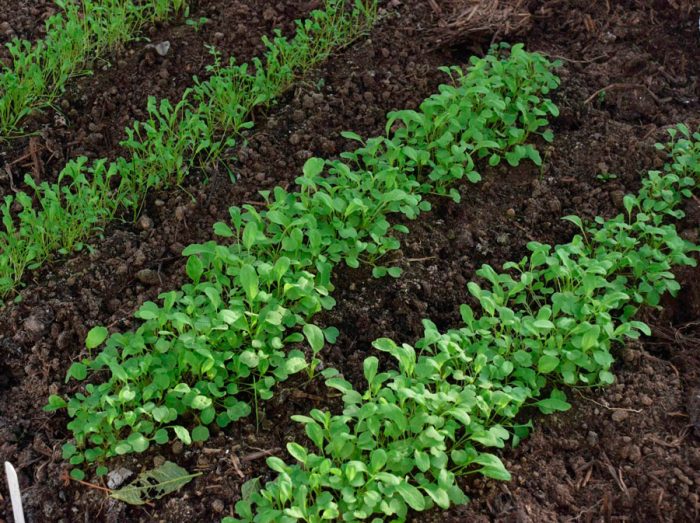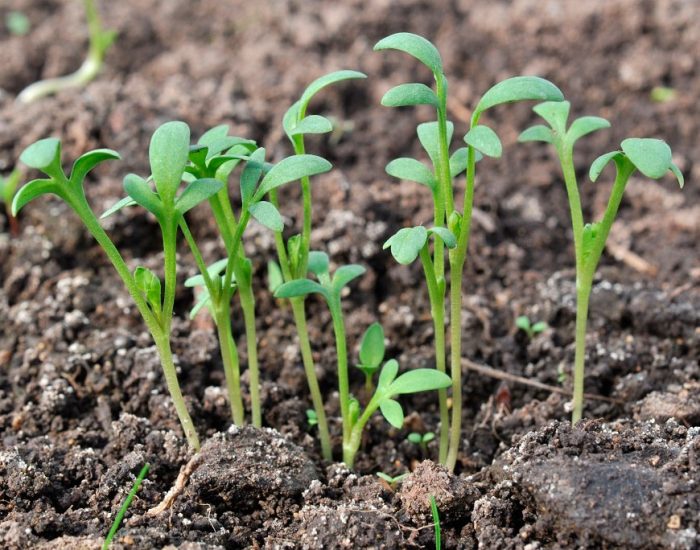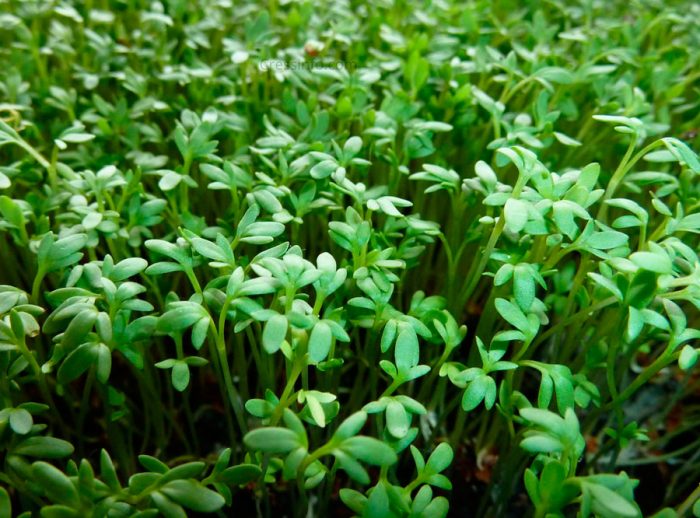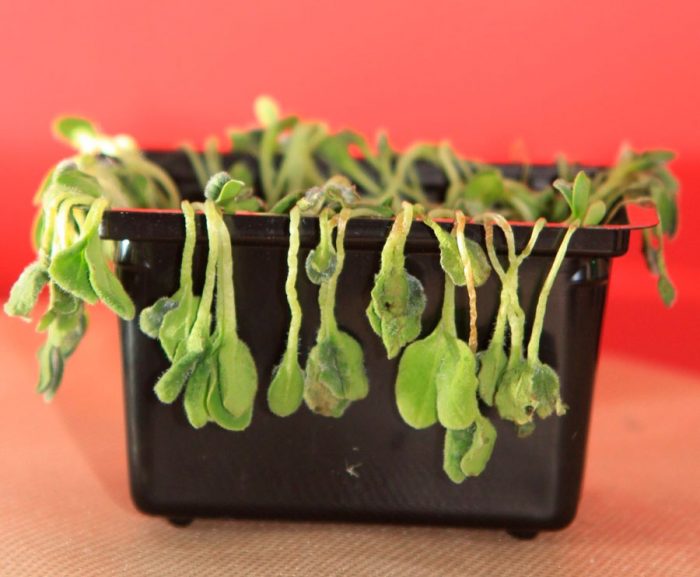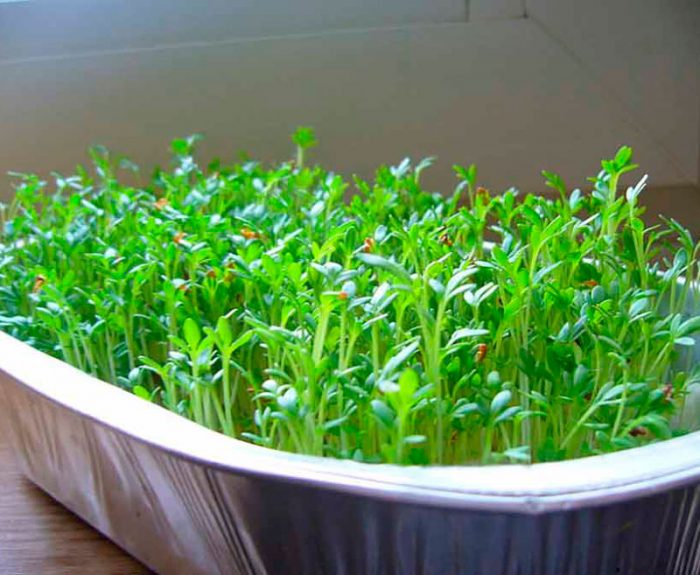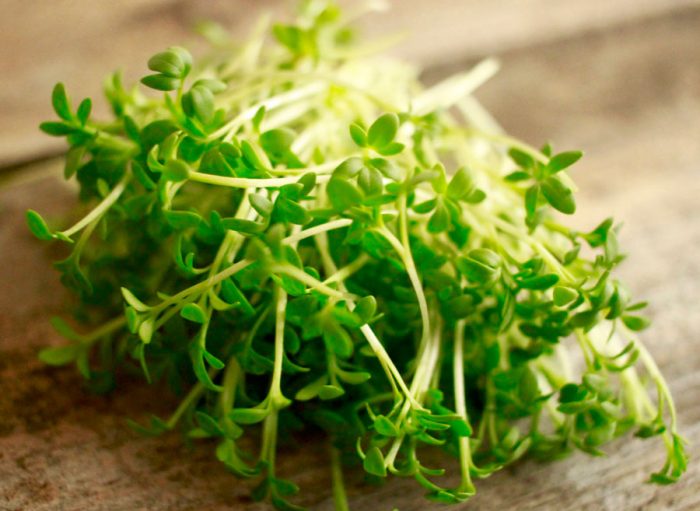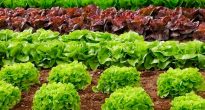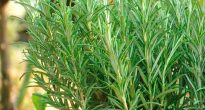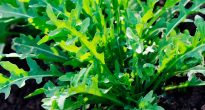The edible herbaceous annual or biennial plant watercress (Lepidium sativum), also called watercress, or bedbug, is a species of the Bugweed genus of the Cruciferous family. Iran is considered its homeland, but today in the wild it can be found in Egypt, Ethiopia, and also in Asia (from Pakistan to the eastern coast of the Mediterranean Sea). On the territory of the modern Mediterranean, the cultivation of watercress has been practiced since ancient times. Over time, the cultivation of culture began to be engaged in throughout the European territory.
Content
Brief description of cultivation
- Landing... Seeds are sown in open ground in March – September. In room conditions, sowing seeds is carried out in October – March. Seedlings are planted in open soil from the second half of April to mid-May.
- Illumination... It grows well in a sunny place and in little shade.
- Priming... The soil can be any, the main thing is that it is nutritious and moderately moist, slightly acidic or neutral.
- Watering... It is necessary to moisten the soil systematically. When grown outdoors during dry periods, watering is carried out every day.
- Fertilizers... This culture is not fed. All necessary fertilizers are applied to the soil during the preparation of the site for planting seedlings or for sowing.
- Reproduction... Seeds.
- Harmful insects... Cruciferous fleas.
- Diseases... Black leg and other rot.
- Properties... Refers to dietary plants.
Features of watercress
The height of the watercress varies from 0.3 to 0.6 m. The bush has a simple root, as well as bare foliage and shoots of a greenish-gray color. The lower leaf plates are single-pinnate and double-pinnate, the middle ones are three-pinnate, and the upper ones are solid, linear in shape. The color of the flowers can be pink or white. The fruit is a pod. Flowering is observed in June or July. Cress is cultivated both indoors and in open soil.
It is very easy to grow it at home. Gardeners consider watercress to be the most unpretentious plant that grows well on the windowsill:
- The first crop can be harvested just 15 days after the seedlings appear.
- The short daylight hours do not harm him, and he also grows well in a small partial shade.
- For planting such a plant, you can take any container.
- Seed material can be purchased at any specialized store, even in summer or winter.
Planting watercress for seedlings
What time to sow for seedlings
If you do not have the opportunity to grow watercress in the open field, then it can be grown indoors throughout the year, while the seeds are sown regularly at intervals of 1-1.5 weeks. However, if you have a piece of land, then sowing seeds can be carried out directly into open soil systematically from March to September, and if desired, in October-March, grow it indoors.
When cultivating on a windowsill, it is recommended to alternate between different varieties of watercress, in this case you will constantly have fresh tasty greens containing a large amount of vitamins.
Features of growing from seeds
To cultivate this plant at home, you need to choose a container, the height of which should be equal to 8-10 centimeters. Sowing seeds can be carried out in a prepared soil mixture or they are evenly distributed on the surface of wet cotton wool, filter paper or blotting paper. There are gardeners who cultivate watercress in one large pot next to other vegetables and herbs. Curly lettuce varieties look very attractive in such mixed plantings.
Growing watercress on a windowsill
At the bottom of the selected container (tray, box, pot or container), a layer of substrate or cotton wool should be laid, the thickness of which should be from 20 to 40 mm. You can fill the container with coconut fiber, sponge, vermiculite, sawdust, ready-made mixture for flowers or seedlings. In this case, it is not recommended to use garden soil, as it can be infected with cruciferous flea beetle eggs, which can cause severe damage to watercress. Seed material is evenly distributed over the surface of the substrate and sprinkled with a thin layer of nutritious soil mixture. The crops are watered from a spray bottle, covered with glass (film) on top and removed to a dark place until the seedlings appear. After the appearance of the first shoots, the shelter is removed, and the container is transferred to a sunny place. At this stage of development of seedlings grown at home, they need an air temperature of about 6-8 degrees, the fact is that in the coolness of the plants a strong root system is formed. After the first true leaf plate grows at the seedlings, they are rearranged to a warmer place, where it will not be higher than 15 degrees. If the seedlings are kept warm, then they will become elongated, worn out and, in the end, will fall. The seedling pot is rotated 180 degrees every day, in this case, the plants will be able to receive uniform lighting.
Watercress is a plant that needs long daylight hours. However, if it is short, then this will not negatively affect the development of the bushes, since this culture is unusually early ripening. In this regard, when growing on a windowsill, it does not need to be additionally illuminated. After the plants are 8–10 centimeters tall, cut them off with scissors and use them to prepare healthy meals.
Watering
When growing watercress at home, it must be systematically moistened with a spray bottle and watered in a timely manner. Do not allow the substrate to dry out or the humidity of the air to be excessively low, as this has an extremely negative effect on the bushes. They begin to age rapidly, their foliage becomes rough, and bitterness appears in its taste, the stem stretches, and shooters begin.In this regard, experts recommend not to plant crops next to heating devices.
Fertilizer
The first feeding with urea is carried out during the formation of the first true leaf plate at the seedlings, for this a nutrient solution is prepared, consisting of 10 liters of water and 25 grams of urea. Such feeding is carried out on the sheet. When 7 days have passed, spill the soil mixture with a solution consisting of 10 liters of water, 10 grams of potassium salt, the same amount of ammonium sulfate and 20 grams of superphosphate. After the harvest is cut, the substrate is again watered with complex feeding, thanks to which the growing seedlings will be provided with nutrients. You can also feed the watercress with the Rainbow liquid fertilizer; for this, a nutrient solution of low concentration is prepared.
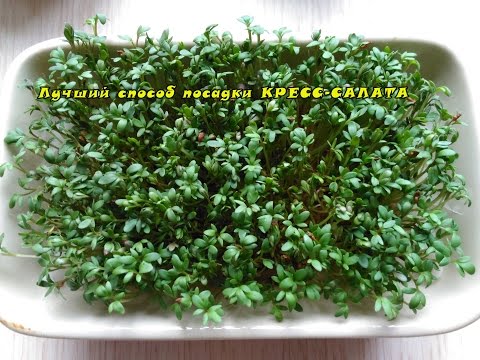

Watch this video on YouTube
Growing watercress outdoors
Landing
In open soil, sowing of watercress seeds is carried out from mid-April to the second half of May (depending on the climatic conditions of the region). For example, in the Moscow region, sowing is carried out later than in Moldova and Ukraine, but earlier than in Siberia. You can start sowing seeds only if the soil in the area thaws to a depth of at least 40 mm, and the air warms up to 6-8 degrees. Podwinter sowing is also suitable for the culture; it is carried out in October before the frost begins.
For the cultivation of watercress, it is recommended to choose an area with soil of a neutral or slightly acidic reaction, while its best predecessors are: onions, potatoes, beets and other root crops. Only those plots where representatives of the Cabbage family were grown are not suitable for growing a crop. It will be very good if the site is illuminated by the sun in the morning and shaded in the midday hours. The preparation of the site should be done in the autumn, for this, it is digged and 20 grams of superphosphate, 5 kilograms of rotted manure and 15 grams of calcium chloride are added to the soil per 1 square meter of the site. In the spring, immediately before sowing, it is recommended to add ammonium sulfate to the ground.
Sowing of seed is carried out in grooves, the depth of which should not be more than 0.5-1 centimeters, while the distance between the rows should be from 10 to 20 centimeters. Watercress seedlings are able to withstand a temperature drop to minus 5 degrees, so there is no need to worry that they will freeze.
Basic rules for growing
It is very easy to grow a culture on your site. Most importantly, remember that for normal growth and development, each plant needs a nutritional area of about 10 square centimeters. In this regard, densely growing seedlings must be thinned out, otherwise their foliage will be small, and the likelihood of their defeat by fungal diseases also increases. When the bushes are watered, gently shallowly loosen the surface of the soil between them, while removing all the weeds on the site.
If a shaded area was chosen for growing such greenery, then it will be possible to grow it there until autumn, while the seeds are regularly sown in the aisles (on average, once every 5-7 days). If the site is sunny, then the cultivation of watercress ends with the onset of hot days, because due to the high air temperature, the shoots of the bushes begin. It is possible to start growing crops again in a well-lit area only in August.
Watering
When grown in a garden bed, the watercress is watered regularly. During the dry period, abundant watering is carried out every day, especially in the summer. If it rains regularly, then the number of watering is reduced to one in three days. And during prolonged rains, the site is not watered at all, because due to the large amount of water in the soil, the bushes become fragile, and they are affected by fungal diseases.In the event that the plant lacks moisture, this will negatively affect its taste, and will also cause the bushes to shoot and damage them with harmful insects.
Fertilizer
It is necessary to feed the crop with great care, because from the moment of planting to harvesting, very little time passes, during which nitrates do not have time to be processed. In this regard, experts advise that all fertilizers be applied to the soil during the preparation of the site for sowing or planting. In the event that, before sowing watercress in the ground, you did not have time to fertilize it, then you need to feed the plant very rarely and use a nutrient solution of a very weak concentration for this.
What can be grown after watercress
In the area where green crops grew, you can grow legumes, onions, cucumbers, tomatoes and potatoes. Since watercress with representatives of the Cabbage family has common diseases and pests, it is not recommended to plant them in this area for several years.


Watch this video on YouTube
Watercress pests and diseases
Watercress diseases
Since watercress ripens very quickly, it simply does not have time to get sick. At least on the site there is no mass destruction of bushes. However, if liquid constantly stagnates in the soil, then because of this, the seedlings can get sick with a black leg, and rot often appears on the bushes during prolonged rains. It is better to dig up and destroy the affected plants, while you can sow watercress again, but in a different area. It is not recommended to spray the bushes with fungicidal preparations, as this can harm your body.
Harmful insects
The cruciferous flea, which can harm all members of the Cruciferous family, is the greatest danger to culture. In order to cleanse the area of the pest, on a fine hot day, the bushes are treated with a decoction of tobacco or pollinated with tobacco dust. In order to avoid the appearance of this harmful insect on the site, it is necessary to strictly adhere to the rules of crop rotation and place areas with Cabbage crops away from each other.
Types and varieties of watercress
There are only three types of garden watercress, called variety forms:
- Whole-leaved... This species unites late broad-leaved varieties with a large horizontal rosette, which reaches 5–6 centimeters in height and 19–21 centimeters across. The best varieties include: Ducat, Whole-leaved and Shirokolistny.
- Curly, or curly... Medium ripening or early ripening varieties with not very large semi-raised or raised rosettes, reaching about 17 centimeters in diameter, which consist of heavily cut leaf plates. The most popular varieties are Azhur, Curchavy, Curchavy cress, Fine Kerld, Garten Krause.
- Sowing, or pinnately dissected... Cultivars belonging to this species fall between curly and whole-leafed varieties. Weakly dissected leaf plates are collected in a large semi-raised rosette. Most often, gardeners choose varieties such as: Narrow-leaved, Zabava, Dansky, Kurled, Extra Curld, Broad Leaf.


Watch this video on YouTube
Properties of watercress: harm and benefit
Medicinal properties of watercress
It is known that 90 percent of watercress consists of a structured liquid that saturates the cells of the human body with moisture. In addition to liquid, such a plant contains complex carbohydrates, proteins, fats and fiber. It contains a lot of vitamins, even more than an orange. For example, shoots and foliage contain vitamins A, E, K, C, B vitamins (folic acid, niacin and choline).Various minerals are also present in watercress, namely: potassium, selenium, magnesium, manganese, zinc, phosphorus, copper, calcium and iron.
Experts advise including watercress in your daily diet, thanks to this, you can significantly reduce the risk of developing prostatitis, cataracts and malignant tumors. It is also recommended for people with thyroid diseases, because it contains iodine. The culture is used in the treatment of kidney and cholelithiasis, and in diseases of the respiratory tract, it is also used for sleep disorders, nervous disorders and depression. And this plant is able to eliminate pain and swelling with inflammation of the joints. With vitamin deficiency in spring, watercress is also very useful.
In alternative medicine, watercress juice is used for anemia, cough, scurvy, and also to gargle a sore throat and to strengthen the body's immune system. The crushed root is used externally for enlarging the prostate gland, and also for treating wounds. Also, ointments are made from the root, which are used for allergies, scabies and scrofula. A powder is made from such a plant, which can replace mustard plasters.
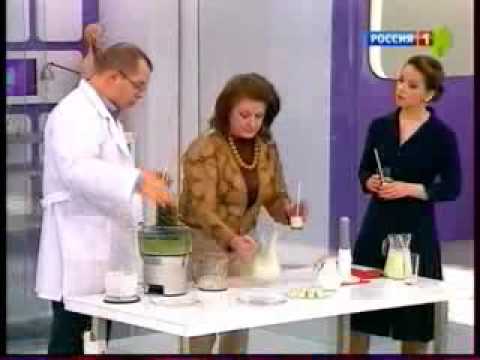

Watch this video on YouTube
Contraindications
Despite all the benefits of watercress, experts do not recommend eating more than three large tablespoons of chopped greens per day, otherwise it can lead to problems with digestion and kidneys. It is not recommended to eat it for colitis, gastritis and duodenitis. Anyone can use the means made on its basis, since no contraindications were found in this case.

